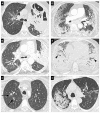Influenza- and COVID-19-Associated Pulmonary Aspergillosis: Are the Pictures Different?
- PMID: 34063556
- PMCID: PMC8156373
- DOI: 10.3390/jof7050388
Influenza- and COVID-19-Associated Pulmonary Aspergillosis: Are the Pictures Different?
Abstract
Invasive pulmonary aspergillosis (IPA) in intensive care unit patients is a major concern. Influenza-associated acute respiratory distress syndrome (ARDS) and severe COVID-19 patients are both at risk of developing invasive fungal diseases. We used the new international definitions of influenza-associated pulmonary aspergillosis (IAPA) and COVID-19-associated pulmonary aspergillosis (CAPA) to compare the demographic, clinical, biological, and radiological aspects of IAPA and CAPA in a monocentric retrospective study. A total of 120 patients were included, 71 with influenza and 49 with COVID-19-associated ARDS. Among them, 27 fulfilled the newly published criteria of IPA: 17/71 IAPA (23.9%) and 10/49 CAPA (20.4%). Kaplan-Meier curves showed significantly higher 90-day mortality for IPA patients overall (p = 0.032), whereas mortality did not differ between CAPA and IAPA patients. Radiological findings showed differences between IAPA and CAPA, with a higher proportion of features suggestive of IPA during IAPA. Lastly, a wide proportion of IPA patients had low plasma voriconazole concentrations with a higher delay to reach concentrations > 2 mg/L in CAPA vs. IAPA patients (p = 0.045). Severe COVID-19 and influenza patients appeared very similar in terms of prevalence of IPA and outcome. The dramatic consequences on the patients' prognosis emphasize the need for a better awareness in these particular populations.
Keywords: CAPA; COVID-19; CT-scan; IAPA; acute respiratory distress syndrome; corticosteroids; influenza; pulmonary aspergillosis; therapeutic drug monitoring; voriconazole.
Conflict of interest statement
J.-P.G. has received research grants and funding from MSD and Pfizer. The other authors report no conflict of interest related to this work.
Figures


References
-
- Donnelly J.P., Chen S.C., Kauffman C.A., Steinbach W.J., Baddley J.W., Verweij P.E., Clancy C.J., Wingard J.R., Lockhart S.R., Groll A.H., et al. Revision and Update of the Consensus Definitions of Invasive Fungal Disease From the European Organization for Research and Treatment of Cancer and the Mycoses Study Group Education and Research Consortium. Clin. Infect. Dis. 2020;71:1367–1376. doi: 10.1093/cid/ciz1008. - DOI - PMC - PubMed
-
- Taccone F.S., Van den Abeele A.-M., Bulpa P., Misset B., Meersseman W., Cardoso T., Paiva J.-A., Blasco-Navalpotro M., De Laere E., Dimopoulos G., et al. Epidemiology of Invasive Aspergillosis in Critically Ill Patients: Clinical Presentation, Underlying Conditions, and Outcomes. Crit. Care. 2015;19:7. doi: 10.1186/s13054-014-0722-7. - DOI - PMC - PubMed
-
- Blot S.I., Taccone F.S., Van den Abeele A.-M., Bulpa P., Meersseman W., Brusselaers N., Dimopoulos G., Paiva J.A., Misset B., Rello J., et al. A Clinical Algorithm to Diagnose Invasive Pulmonary Aspergillosis in Critically Ill Patients. Am. J. Respir. Crit. Care Med. 2012;186:56–64. doi: 10.1164/rccm.201111-1978OC. - DOI - PubMed
-
- Loughlin L., Hellyer T.P., White P.L., McAuley D.F., Conway Morris A., Posso R.B., Richardson M.D., Denning D.W., Simpson A.J., McMullan R. Pulmonary Aspergillosis in Patients with Suspected Ventilator-Associated Pneumonia in UK ICUs. Am. J. Respir. Crit. Care Med. 2020;202:1125–1132. doi: 10.1164/rccm.202002-0355OC. - DOI - PMC - PubMed
-
- Maertens J., Theunissen K., Verbeken E., Lagrou K., Verhaegen J., Boogaerts M., Eldere J.V. Prospective Clinical Evaluation of Lower Cut-Offs for Galactomannan Detection in Adult Neutropenic Cancer Patients and Haematological Stem Cell Transplant Recipients. Br. J. Haematol. 2004;126:852–860. doi: 10.1111/j.1365-2141.2004.05140.x. - DOI - PubMed
LinkOut - more resources
Full Text Sources

